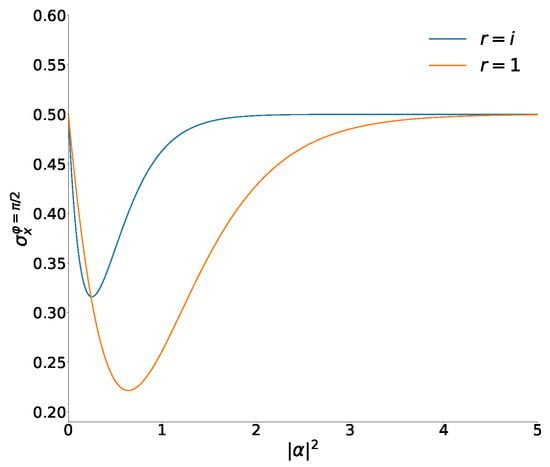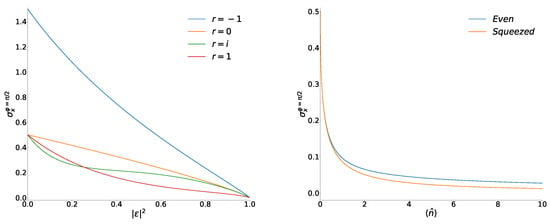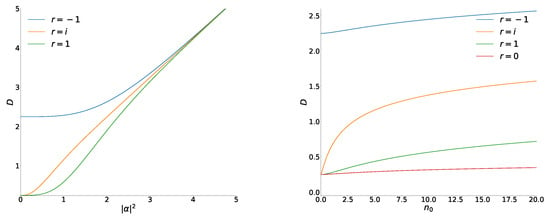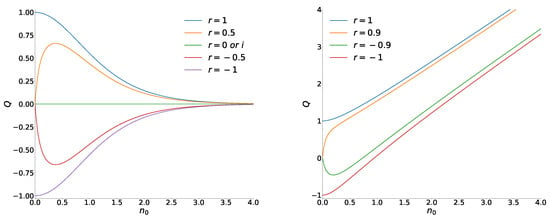Abstract
We calculate the second-order moments, the Robertson–Schrödinger uncertainty product, and the Mandel factor for various superpositions of coherent phase states with opposite arguments, comparing the results with similar superpositions of the usual (Klauder–Glauber–Sudarshan) coherent states. We discover that the coordinate variance in the analog of even coherent states can show the most strong squeezing effect, close to the maximal possible squeezing for the given mean photon number. On the other hand, the Robertson–Schrödinger (RS) uncertainty product in superpositions of coherent phase states increases much slower (as function of the mean photon number) than in superpositions of the usual coherent states. A nontrivial behavior of the Mandel factor for small mean photon numbers is discovered in superpositions with unequal weights of two components. An exceptional nature of the even and odd superpositions is demonstrated.
1. Introduction
Since the beginning of 1960s, one of the main tools in quantum mechanics and quantum optics is the Klauder–Glauber–Sudarshan coherent state (CS) [1,2,3],
where the Fock state [4] is the eigenstate of the number operator : , and may be an arbitrary complex number. Here, and are the bosonic creation and annihilation operators satisfying the canonical commutation relation . The coherent state (1) is the eigenstate of the annihilation operator :
Among numerous generalizations of the state (1) (see, e.g., reviews [5,6,7,8,9,10,11]), we distinguish here the family of the coherent phase states (CPS) [12,13,14,15,16,17,18,19,20,21] (called also as “harmonious states” [22] and “pseudothermal states” [23]),
introduced as eigenstates of the Susskind–Glogower exponential phase operator [24],
Another important family of quantum states, which turned out useful for many applications of quantum mechanics and quantum information, consists of normalized superpositions of coherent states and of the form [7]
The most interesting choices of parameter r are related to the values , which correspond to the even and odd coherent states introduced by Dodonov, Malkin, and Man’ko [25]. The choice was made by Yurke and Stoler [26].
In this paper, we study the properties of analogs of states (6), where the usual coherent states are replaced with the coherent phase states (3):
If , the normalization factor assumes the form
with the following special values:
The superpositions (6) and (8) are eigenstates of squares of the corresponding annihilation operators:
Even and odd superpositions of the CPS have the following expansions in the Fock basis:
The states (12) were considered in paper [27]. However, their statistical properties were studied in that paper for moderate values of parameter only, while the most interesting features can be observed in the limit , as will be shown in the following sections. Truncated series were considered in [28] but only for small truncation numbers.
Functions and characterize the overlaps between the wave functions with opposite arguments. In the case of usual coherent states, these Gaussian functions are rather narrow and well localized. For this reason, their scalar product decreases exponentially when the distance between two components of the superposition increases. On the other hand, the non-Gaussian wave functions of the coherent phase states are rather wide so that the related overlap integral decays much more slowly as function of parameter . The goal of this paper is to study what the physical consequences of these differences are. For example, it is known that usual coherent states have no squeezing of the canonical position and momentum operators (we assume ),
for any value of the complex parameter . On the other hand, we discovered recently [21] that strong squeezing is possible for the CPS with when . Therefore, it is interesting to know whether the degree of squeezing can be enhanced even more in the states (8), remembering that small squeezing was observed in the even coherent states [29]. This question is discussed in Section 3. All necessary formulas for the mean values, variances, and covariances
for the pair of operators in the states (6) and (8) are derived in Section 2.
In Section 4, we compare the Robertson–Schrödinger uncertainty relations [30,31] in the states (6) and (8). It is known that the Heisenberg product of uncertainties attains the minimal possible value for all usual coherent states. On the other hand, its generalization – the Robertson–Schrödinger uncertainty combination – slowly increases logarithmically as in the CPS [21]. Therefore, it is interesting to know the behavior of the RS uncertainty product in the superposition states.
In Section 5, we compare the Mandel factor for two families of superposition states. This factor equals zero identically for all coherent states. On the other hand, it can be negative for usual odd coherent states. Now, we study the dependence of this factor on and r in the superpositions of coherent phase states.
2. Mean Values and Variances
The mean value of any operator in the superposition (8) is a sum of four terms:
Taking and , we obtain the following expressions for mean values of the creation and annihilation operators:
Mean values of the quadrature components (13) are as follows:
The most simple expressions arise for the “equal weights” superpositions with . Then, if , i.e., for even and odd superpositions, for all values of . On the other hand, these mean values can be nonzero for the Yurke–Stoler superpositions with .
For the second-order mean values, Equation (14) leads to the following formulas:
The mean number of quanta, , can be calculated with the aid of Equation (14) and formulas
The result is
In particular,
Note that, as a matter of fact, three apparently different expressions in Equation (22) give the same results in the limit .
The coordinate and momentum variances in the three special cases are as follows:
For , we have
In all four special cases, the coordinate variances attain minimal values for . The explicit formulas in this case are as follows:
The following expressions are obtained for the coordinate-momentum covariance:
Approximate analytical expressions can be obtained for the series if one uses the expansion
The three-term approximate equality (35) is quite reasonable even for , and its accuracy improves significantly for bigger values of n. Then, using the exact formula
we obtain the following approximate analytical expressions:
Usual Coherent States
3. Squeezing
Formulas for the variances of the coordinate and momentum operators obtained in Section 2 show that the coordinate variance attains minimal values for the phase , both for superpositions of usual coherent states and superpositions of coherent phase states. However, concrete minimal values are quite different for these two kinds of superpositions.
3.1. Usual Coherent States
Equations (42)–(44) show that a moderate squeezing can be achieved for the even and Yurke–Stoler superpositions with :
For , a stronger squeezing is observed for the YS-superpositions. However, the minimal absolute squeezing is attained for the even superpositions. The concrete minimal values in two superpositions are as follows:
When and , all coordinate variances tend to the asymptotic value . Two functions of Equation (47) are illustrated in Figure 1.

Figure 1.
Variances as functions of in the even and YS superpositions of the usual coherent states with .
3.2. Coherent Phase States
On the contrary, the coordinate variances in the superpositions of coherent phase states go to zero when and . This behavior is shown in Figure 2.

Figure 2.
(Left) Variances of as functions of in the superpositions of the coherent phase states with . (Right) Variances of as functions of in the even superposition of the coherent phase states with compared with the variances (50) in the ideal vacuum squeezed state. All numeric results were obtained taking into account terms in series and .
Equations (29) and (30) show that the minimal variance in the Yurke–Stoler superpositions is always smaller than in the coherent phase state (when ). Moreover, the squeezing in the YS-superpositions is the strongest for small values of , as can be seen in the first terms of the Taylor expansions of exact formulas (23)–(26):
However, if , the strongest squeezing is observed in the even superpositions. The variances and practically coincide for the values of close to unity because the sign-variable series in Equation (29) remains limited when . The behavior of the minimal variances for small differences can be described analytically with the aid of Equation (36). The leading terms of asymptotical forms of all functions (27)–(30) at are as follows:
A thorough analysis and the comparison of (48) with a similar result of paper [21] for show that the approximation (48) is valid for extremely high values of the mean photon number , namely, under the condition .
Remember that the coordinate variance in the ideal pure vacuum squeezed (Gaussian) state, with , as a function of the mean number of quanta , is given by the known formula
This is the minimal possible value of for the fixed mean photon number [8,32,33]. On the right-hand side of Figure 2, we compare functions (27) and (50) for moderate values of the mean photon number . The asymptotic form of function (50)
shows that the squeezing effect in the coherent phase states and their superpositions is only slightly weaker than in the squeezed vacuum states when .
4. The Robertson–Schrödinger Uncertainty Products
The Robertson–Schrödinger uncertainty relation has the form
The equality holds for Gaussian pure states, including the usual coherent states with arbitrary values of parameter . Since for non-Gaussian states, it is interesting to know how this generalized uncertainty product depends on parameters , , and r.
4.1. Usual Coherent States
4.2. Coherent Phase States
The following expressions hold for the superpositions of coherent phase states:
In Figure 3, we compare the RS uncertainty products in the superpositions of usual coherent states and coherent phase states, plotting these quantities as functions of the argument . This means that on the right-hand side, whereas on the left-hand side.

Figure 3.
The Robertson–Schrödinger uncertainty product D for superpositions of coherent states (left) and coherent phase states (right) as functions of the mean number of quanta in the states with . All numeric results were obtained taking into account terms in series and .
All expressions, (52)–(58), do not contain the phase of the complex arguments and . This fact can be understood if one takes into account the equivalence between the phase change and time evolution. Indeed, the time evolution of states (1) and (3) of a quantum harmonic oscillator with frequency is reduced to the linear evolution of phases of complex parameters and : . On the other hand, the quantity D is the simplest quantum universal invariant, which preserves its value during the time evolution governed by any quadratic one-dimensional Hamiltonian [34,35].
Finding exact numeric values of functions and is rather difficult task when is close to unity. Indeed, using Equations (55)–(56), one has to find the small difference of very big numbers. The main difficulty is to calculate the slowly convergent series with high precision. For example, if (i.e., ), we have if only . However, an approximate asymptotical behavior of functions (55) and (56) can be easily found if one takes into account that a consequence of Equations (23)–(24) and (55)–(56) is the formula
On the other hand, for , when , we have the relations
Since when , in this limit, we can write
Taking into account Equation (48), we arrive at the following asymptotic expression:
The difference remains finite when (contrary to the case of usual coherent states): .
5. The Mandel Factor
The Mandel factor [36]
can be easily calculated analytically, both for superpositions (6) and superpositions (8).
5.1. Usual Coherent States
For superpositions (6), we obtain
where is defined in Equation (7). Note the (anti)symmetry property . The Mandel factor equals zero not only for the coherent states but for their Yurke–Stoler superpositions as well. Asymptotically, for . If , then , provided . For the exceptional even and odd superpositions, we have another behavior: at . All these features are clearly seen on the left-hand side of Figure 4.
5.2. Coherent Phase States
The general formula for superpositions (8) has the form
Here, was defined in Equation (9). It can also be written in terms of the mean number of quanta in the coherent phase state
We see that (as for the thermal states), if (in particular, for the single coherent phase states and the Yurke–Stoler superpositions). The asymptotical behavior for is given by the formula . For , we obtain if , while if . If , the Mandel factor goes to zero when . However, its behavior is different for positive and negative values of parameter R. If and , then
Illustrations of the function are given on the right-hand side of Figure 4.
6. Conclusions
We have compared the most popular measures of “non-classicality” – the degree of squeezing and the Mandel factor – in two families of quantum superposition states. The strongest squeezing can be observed in the even superpositions. In the case of coherent phase states, the minimal quadrature variance goes to zero in all three basic kinds of superpositions: even, odd, and Yurke–Stoler ones, when the mean number of quanta goes to infinity. For small mean numbers of quanta, the squeezing effect is stronger for the Yurke–Stoler superpositions, both for the usual and coherent phase states.
Significant differences are observed also in the behavior of the Mandel factor. In the case of usual coherent states, the type of statistics (sub- or super-Poissonian) does not depend on the mean photon number in the initial coherent state , and the Q-factor tends to zero with an exponential accuracy when , for all superpositions. On the other hand, the sub-Poissonian statistics of superpositions of the coherent phase states is observed for odd superpositions with small mean photon numbers. For high mean photon numbers, the statistics is super-Poissonian for all kinds of superpositions. It is interesting that the difference tends to the nonzero (unit) value if . In this limit, , almost as in the thermal quantum states. Another interesting feature of the Q-factor is that this factor tends to zero when or for all superpositions, except for two distinguished special cases: for . If the coefficient r is close to , the functions or rapidly become very close to the corresponding exceptional functions or . If r is a pure imaginary number, the photon statistics in superpositions coincides with that of the initial coherent states (or coherent phase states).
In the case of superpositions of usual coherent states, each component is described by the Gaussian wave function. It is known that the Robertson–Schrödinger uncertainty product does not depend on the argument for all Gaussian states. However, this product increases approximately as in the case of superpositions with . On the other hand, the RS uncertainty product in superpositions of coherent phase states (where each component is non-Gaussian) grows much more slowly (approximately logarithmically) as the function of the mean number of quanta .
Author Contributions
M.C.d.F.: analytical and numerical calculations, plotting figures; V.V.D.: conceptualization, methodology, analytical calculations and writing the paper. All authors have read and agreed to the published version of the manuscript.
Funding
This research received no external funding.
Institutional Review Board Statement
Not applicable.
Data Availability Statement
Data are contained within the article.
Acknowledgments
V.V.D. acknowledges partial financial supports from Brazilian funding agencies National Council for Scientific and Technological Development (CNPq) and Fundação de Apoio à Pesquisa do Distrito Federal (FAPDF), grant number 00193-00001817/2023-43. M.C.F. acknowledges a support from the Brazilian funding agency CAPES, process 88887.007464/2024-00.
Conflicts of Interest
The authors declare no conflict of interest.
References
- Klauder, J.R. The action option and a Feynman quantization of spinor fields in terms of ordinary c-numbers. Ann. Phys. 1960, 11, 123–168. [Google Scholar] [CrossRef]
- Glauber, R.J. Photon correlations. Phys. Rev. Lett. 1963, 10, 84–86. [Google Scholar] [CrossRef]
- Sudarshan, E.C.G. Equivalence of semiclassical and quantum mechanical descriptions of statistical light beams. Phys. Rev. Lett. 1963, 10, 277–279. [Google Scholar] [CrossRef]
- Fock, V. Verallgemeinerung und Lösung der Diracschen statistischen Gleichung. Z. Phys. 1928, 49, 339–357. [Google Scholar] [CrossRef]
- Perelomov, A.M. Generalized coherent states and some of their applications. Sov. Phys. Uspekhi 1977, 20, 703–720. [Google Scholar] [CrossRef]
- Zhang, W.-M.; Feng, D.H.; Gilmore, R. Coherent states: Theory and some applications. Rev. Mod. Phys. 1990, 62, 867–927. [Google Scholar] [CrossRef]
- Brif, C. Two-photon algebra eigenstates. A unified approach to squeezing. Ann. Phys. 1996, 251, 180–207. [Google Scholar] [CrossRef][Green Version]
- Dodonov, V.V. ‘Nonclassical’ states in quantum optics: A ‘squeezed’ review of first 75 years. J. Opt. B Quantum Semiclassical Opt. 2002, 4, R1–R33. [Google Scholar] [CrossRef]
- Kastrup, H.A. Quantization of the optical phase space S2 = {φ mod 2π, I > 0} in terms of the group SO↑(1, 2). Fortschritte Phys. 2003, 51, 975–1134. [Google Scholar] [CrossRef]
- Vourdas, A. Analytic representations in quantum mechanics. J. Phys. A Math. Gen. 2006, 39, R65–R141. [Google Scholar] [CrossRef]
- Dell’Anno, F.; De Siena, S.; Illuminati, F. Multiphoton quantum optics and quantum state engineering. Phys. Rep. 2006, 428, 53–168. [Google Scholar] [CrossRef]
- Lerner, E.C.; Huang, H.W.; Walters, G.E. Some mathematical properties of oscillator phase operator. J. Math. Phys. 1970, 11, 1679–1684. [Google Scholar] [CrossRef]
- Aharonov, Y.; Lerner, E.C.; Huang, H.W.; Knight, J.M. Oscillator phase states, thermal equilibrium and group representations. J. Math. Phys. 1973, 14, 746–756. [Google Scholar] [CrossRef]
- Lévy-Leblond, J.-M. Who is afraid of nonhermitian operators? A quantum description of angle and phase. Ann. Phys. 1976, 101, 319–341. [Google Scholar] [CrossRef]
- Vourdas, A. SU(2) and SU(1;1) phase states. Phys. Rev. A 1990, 41, 1653–1661. [Google Scholar] [CrossRef]
- Shapiro, J.H.; Shepard, S.R. Quantum phase measurement: A system-theory perspective. Phys. Rev. A 1991, 43, 3795–3818. [Google Scholar] [CrossRef]
- Vourdas, A.; Brif, C.; Mann, A. Factorization of analytic representations in the unit disc and number-phase statistics of a quantum harmonic oscillator. J. Phys. A Math. Gen. 1996, 29, 5887–5898. [Google Scholar] [CrossRef]
- Wünsche, A. A class of phase-like states. J. Opt. B Quantum Semiclassical Opt. 2001, 3, 206–218. [Google Scholar] [CrossRef]
- Dodonov, V.V.; Mizrahi, S.S. Creating quanta with an ‘annihilation’ operator. J. Phys. A Math. Gen. 2002, 35, 8847–8857. [Google Scholar]
- Gazeau, J.-P.; Hussin, V.; Moran, J.; Zelaya, K. Generalized Susskind–Glogower coherent states. J. Math. Phys. 2021, 62, 072104. [Google Scholar] [CrossRef]
- de Freitas, M.C.; Dodonov, V.V. Coherent phase states in the coordinate and Wigner representations. Quantum Rep. 2022, 4, 509–522. [Google Scholar] [CrossRef]
- Sudarshan, E.C.G. Diagonal harmonious state representation. Int. J. Theor. Phys. 1993, 32, 1069–1076. [Google Scholar] [CrossRef]
- Dodonov, V.V.; Mizrahi, S.S. Uniform nonlinear evolution equations for pure and mixed quantum states. Ann. Phys. 1995, 237, 226–268. [Google Scholar] [CrossRef]
- Susskind, L.; Glogower, J. Quantum mechanical phase and time operator. Physics 1964, 1, 49–61. [Google Scholar] [CrossRef]
- Dodonov, V.V.; Malkin, I.A.; Man‘ko, V.I. Even and odd coherent states and excitations of a singular oscillator. Physica 1974, 72, 597–615. [Google Scholar] [CrossRef]
- Yurke, B.; Stoler, D. Generating quantum mechanical superpositions of macroscopically distinguishable states via amplitude dispersion. Phys. Rev. Lett. 1986, 57, 13–16. [Google Scholar] [CrossRef] [PubMed]
- Obada, A.-S.F.; Darwish, M. Partial phase state as a nonlinear coherent state and some of its properties. J. Mod. Opt. 2004, 51, 209–222. [Google Scholar] [CrossRef]
- Obada, A.-S.F.; Yassin, O.M.; Barnett, S.M. Phase properties of coherent phase and generalized geometric states. J. Mod. Opt. 1997, 44, 149–161. [Google Scholar] [CrossRef]
- Bužek, V.; Vidiella-Barranco, A.; Knight, P.L. Superpositions of coherent states: Squeezing and dissipation. Phys. Rev. A 1992, 45, 6570–6585. [Google Scholar] [CrossRef]
- Schrödinger, E. Zum Heisenbergschen Unschärfeprinzip. Sitzungsberichte der Preussischen Akademie der Wissenschaften. Physikalisch-mathematische Klasse; Akademie der Wissenschaften: Berlin, Germany, 1930; pp. 296–303. [Google Scholar]
- Robertson, H.P. A general formulation of the uncertainty principle and its classical interpretation. Phys. Rev. 1930, 35, 667. [Google Scholar]
- Ritze, H.H.; Bandilla, A. Squeezing and first-order coherence. J. Opt. Soc. Am. B 1987, 4, 1641–1644. [Google Scholar] [CrossRef]
- Lukš, A.; Peřinová, V.; Hradil, Z. Principal squeezing. Acta Phys. Pol. A 1988, 74, 713–721. [Google Scholar]
- Dodonov, V.V. Universal integrals of motion and universal invariants of quantum systems. J. Phys. A Math. Gen. 2000, 33, 7721–7738. [Google Scholar] [CrossRef]
- Dodonov, V.V.; Man’ko, O.V. Universal invariants of quantum-mechanical and optical systems. J. Opt. Soc. Am. A 2000, 17, 2403–2410. [Google Scholar] [CrossRef]
- Mandel, L. Sub-Poissonian photon statistics in resonance fluorescence. Opt. Lett. 1979, 4, 205–207. [Google Scholar] [CrossRef]
Disclaimer/Publisher’s Note: The statements, opinions and data contained in all publications are solely those of the individual author(s) and contributor(s) and not of MDPI and/or the editor(s). MDPI and/or the editor(s) disclaim responsibility for any injury to people or property resulting from any ideas, methods, instructions or products referred to in the content. |
© 2024 by the authors. Licensee MDPI, Basel, Switzerland. This article is an open access article distributed under the terms and conditions of the Creative Commons Attribution (CC BY) license (https://creativecommons.org/licenses/by/4.0/).
